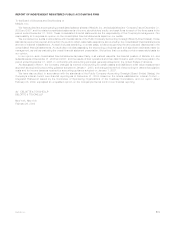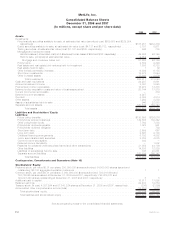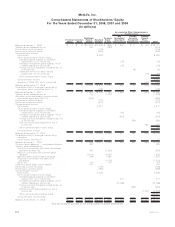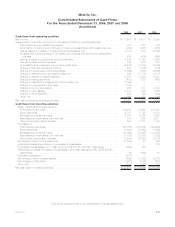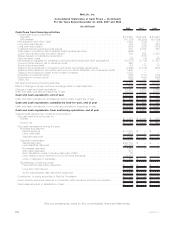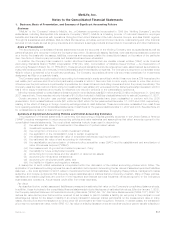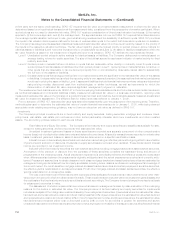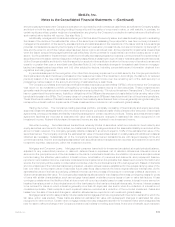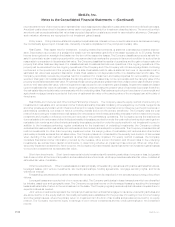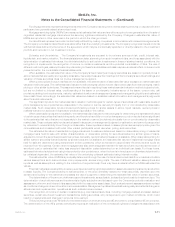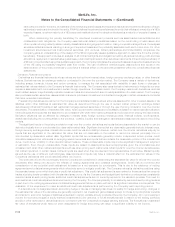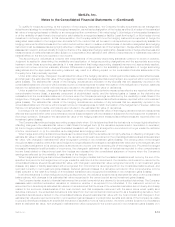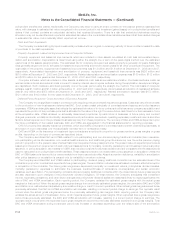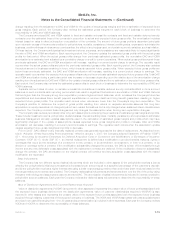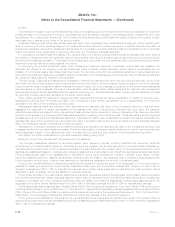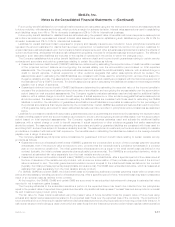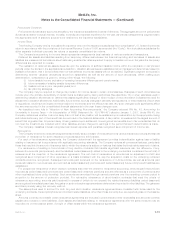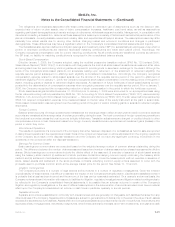MetLife 2008 Annual Report Download - page 134
Download and view the complete annual report
Please find page 134 of the 2008 MetLife annual report below. You can navigate through the pages in the report by either clicking on the pages listed below, or by using the keyword search tool below to find specific information within the annual report.Funding agreements represent arrangements where the Company has long-term interest bearing amounts on deposit with third
parties and are generally stated at amortized cost.
Mortgage servicing rights (“MSRs”) are measured at estimated fair value and are either acquired or are generated from the sale of
originated residential mortgage loans where the servicing rights are retained by the Company. Changes in estimated fair value of
MSRs are reported in other revenues in the period in which the change occurs.
Funds withheld represent amounts contractually withheld by ceding companies in accordance with reinsurance agreements.
The Company records a funds withheld receivable rather than the underlying investments. The Company recognizes interest on funds
withheld at rates defined by the terms of the agreement which may be contractually specified or directly related to the investment
portfolio and records it in net investment income.
Estimates and Uncertainties. The Company’s investments are exposed to four primary sources of risk: credit, interest rate,
liquidity risk, and market valuation. The financial statement risks, stemming from such investment risks, are those associated with the
determination of estimated fair values, the diminished ability to sell certain investments in times of strained market conditions, the
recognition of impairments, the recognition of income on certain investments, and the potential consolidation of VIEs. The use of
different methodologies, assumptions and inputs relating to these financial statement risks may have a material effect on the amounts
presented within the consolidated financial statements.
When available, the estimated fair value of the Company’s fixed maturity and equity securities are based on quoted prices in
active markets that are readily and regularly obtainable. Generally, these are the most liquid of the Company’s securities holdings and
valuation of these securities does not involve management judgment.
When quoted prices in active markets are not available, the determination of estimated fair value is based on market standard
valuation methodologies. The market standard valuation methodologies utilized include: discounted cash flow methodologies, matrix
pricing or other similar techniques. The assumptions and inputs in applying these market standard valuation methodologies include,
but are not limited to: interest rates, credit standing of the issuer or counterparty, industry sector of the issuer, coupon rate, call
provisions, sinking fund requirements, maturity, estimated duration and management’s assumptions regarding liquidity and estimated
future cash flows. Accordingly, the estimated fair values are based on available market information and management’s judgments
about financial instruments.
The significant inputs to the market standard valuation methodologies for certain types of securities with reasonable levels of
price transparency are inputs that are observable in the market or can be derived principally from or corroborated by observable
market data. Such observable inputs include benchmarking prices for similar assets in active, liquid markets, quoted prices in
markets that are not active and observable yields and spreads in the market.
When observable inputs are not available, the market standard valuation methodologies for determining the estimated fair value
of certain types of securities that trade infrequently, and therefore have little or no price transparency, rely on inputs that are significant
to the estimated fair value that are not observable in the market or cannot be derived principally from or corroborated by observable
market data. These unobservable inputs can be based in large part on management judgment or estimation, and cannot be supported
by reference to market activity. Even though unobservable, these inputs are based on assumptions deemed appropriate given the
circumstances and consistent with what other market participants would use when pricing such securities.
The estimated fair value of residential mortgage loans held-for-sale are determined based on observable pricing of residential
mortgage loans held-for-sale with similar characteristics, or observable pricing for securities backed by similar types of loans,
adjusted to convert the securities prices to loan prices. Generally, quoted market prices are not available. When observable pricing for
similar loans or securities that are backed by similar loans are not available, the estimated fair values of residential mortgage loans
held-for-sale are determined using independent broker quotations, which is intended to approximate the amounts that would be
received from third parties. Certain other mortgages have also been designated as held-for-sale which are recorded at the lower of
amortized cost or estimated fair value less expected disposition costs determined on an individual loan basis. For these loans,
estimated fair value is determined using independent broker quotations or, when the loan is in foreclosure or otherwise determined to
be collateral dependent, the estimated fair value of the underlying collateral estimated using internal models.
The estimated fair value of MSRs is principally determined through the use of internal discounted cash flow models which utilize
various assumptions as to discount rates, loan-prepayments, and servicing costs. The use of different valuation assumptions and
inputs as well as assumptions relating to the collection of expected cash flows may have a material effect on MSRs estimated fair
values.
Financial markets are susceptible to severe events evidenced by rapid depreciation in asset values accompanied by a reduction
in asset liquidity. The Company’s ability to sell securities, or the price ultimately realized for these securities, depends upon the
demand and liquidity in the market and increases the use of judgment in determining the estimated fair value of certain securities.
The determination of the amount of allowances and impairments, as applicable, is described previously by investment type. The
determination of such allowances and impairments is highly subjective and is based upon the Company’s periodic evaluation and
assessment of known and inherent risks associated with the respective asset class. Such evaluations and assessments are revised
as conditions change and new information becomes available. Management updates its evaluations regularly and reflects changes in
allowances and impairments in operations as such evaluations are revised.
The recognition of income on certain investments (e.g. loan-backed securities, including mortgage-backed and asset-backed
securities, certain structured investment transactions, trading securities, etc.) is dependent upon market conditions, which could
result in prepayments and changes in amounts to be earned.
The accounting rules under FIN 46(r) for the determination of when an entity is a VIE and when to consolidate a VIE are complex.
The determination of the VIE’s primary beneficiary requires an evaluation of the contractual rights and obligations associated with
F-11MetLife, Inc.
MetLife, Inc.
Notes to the Consolidated Financial Statements — (Continued)


